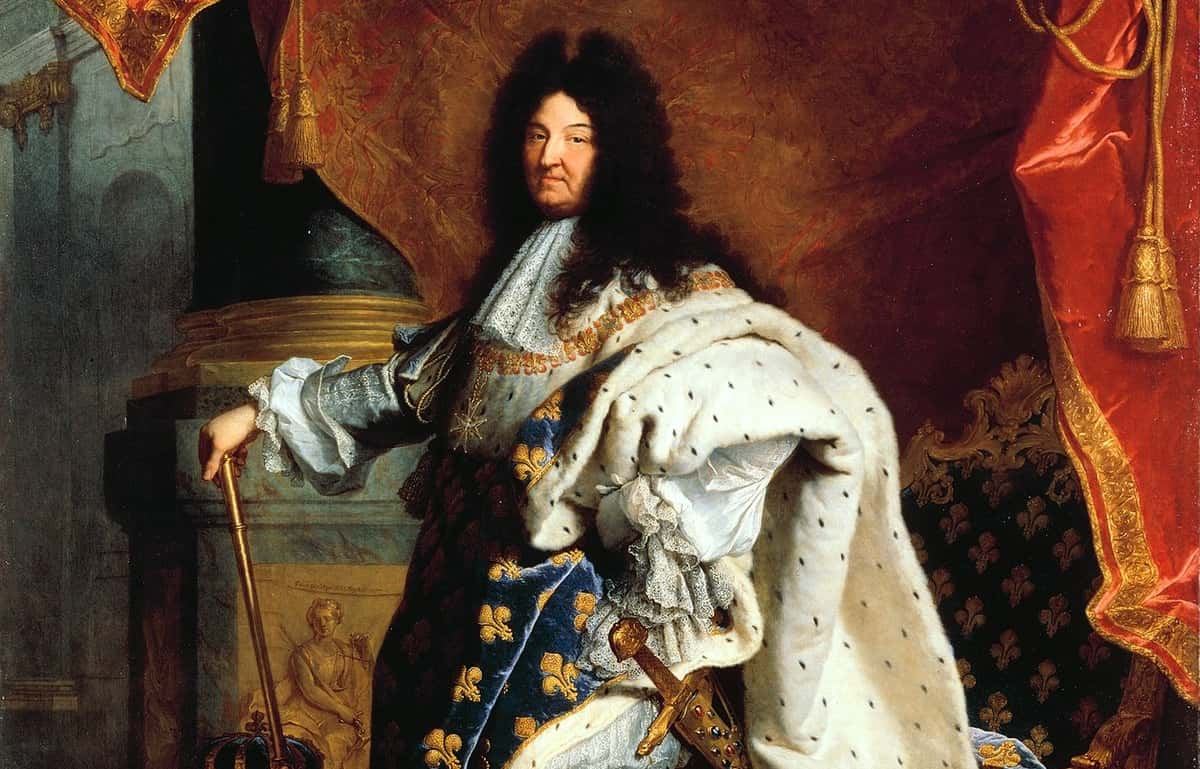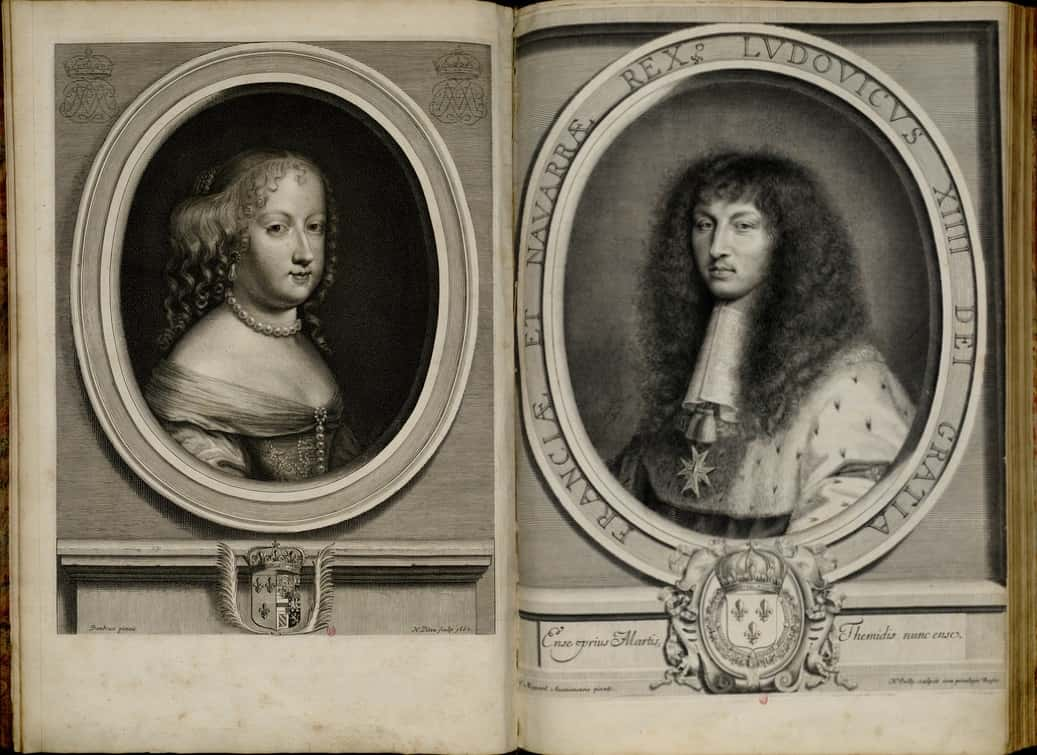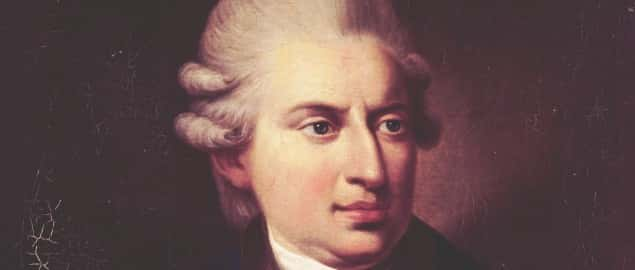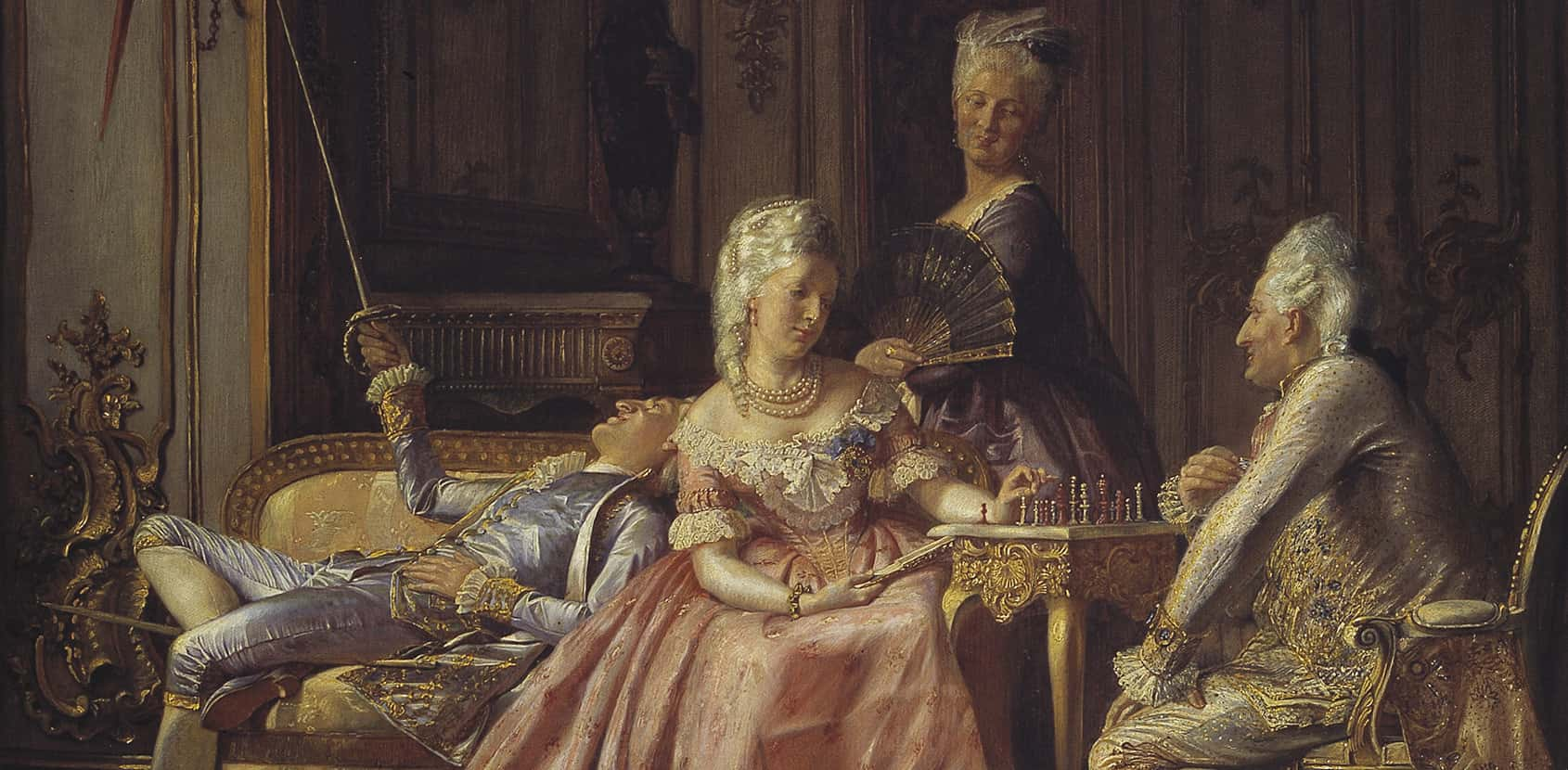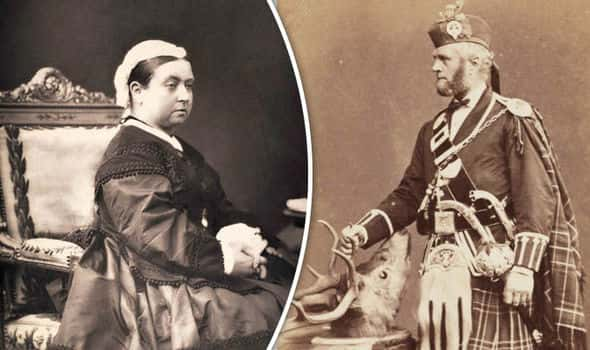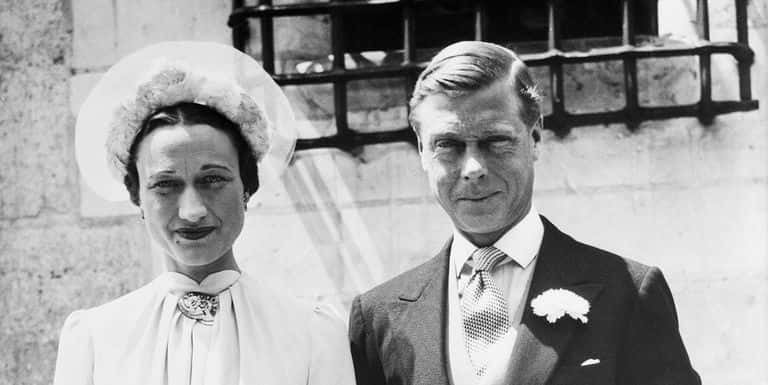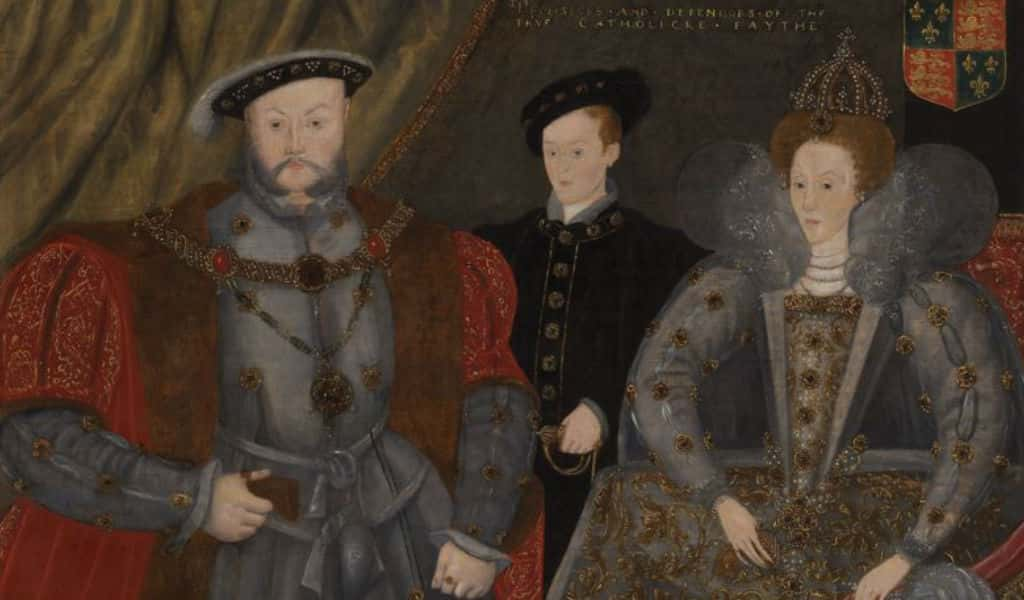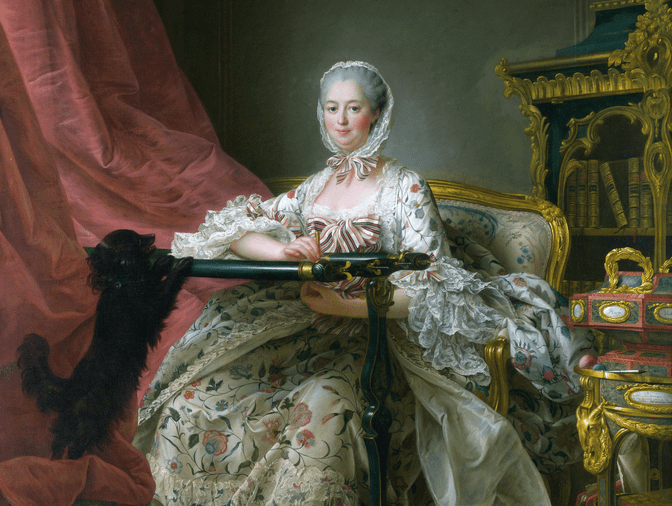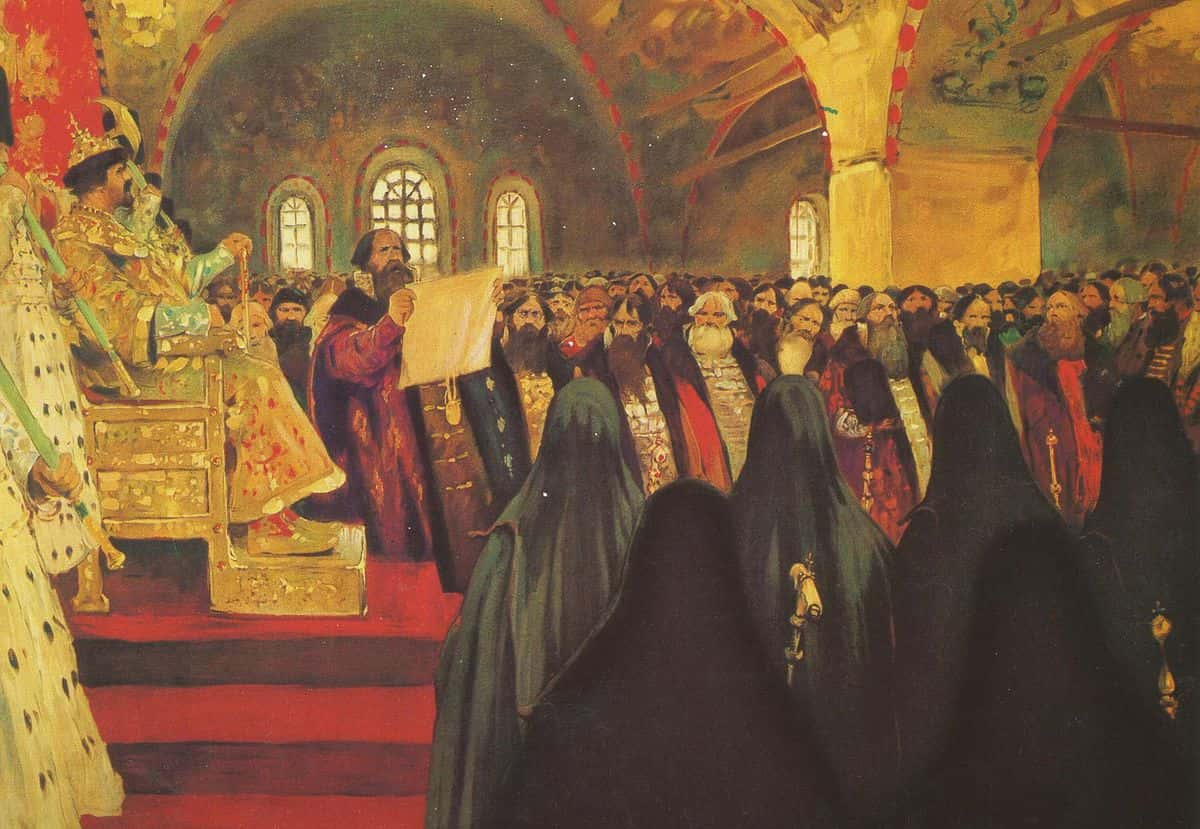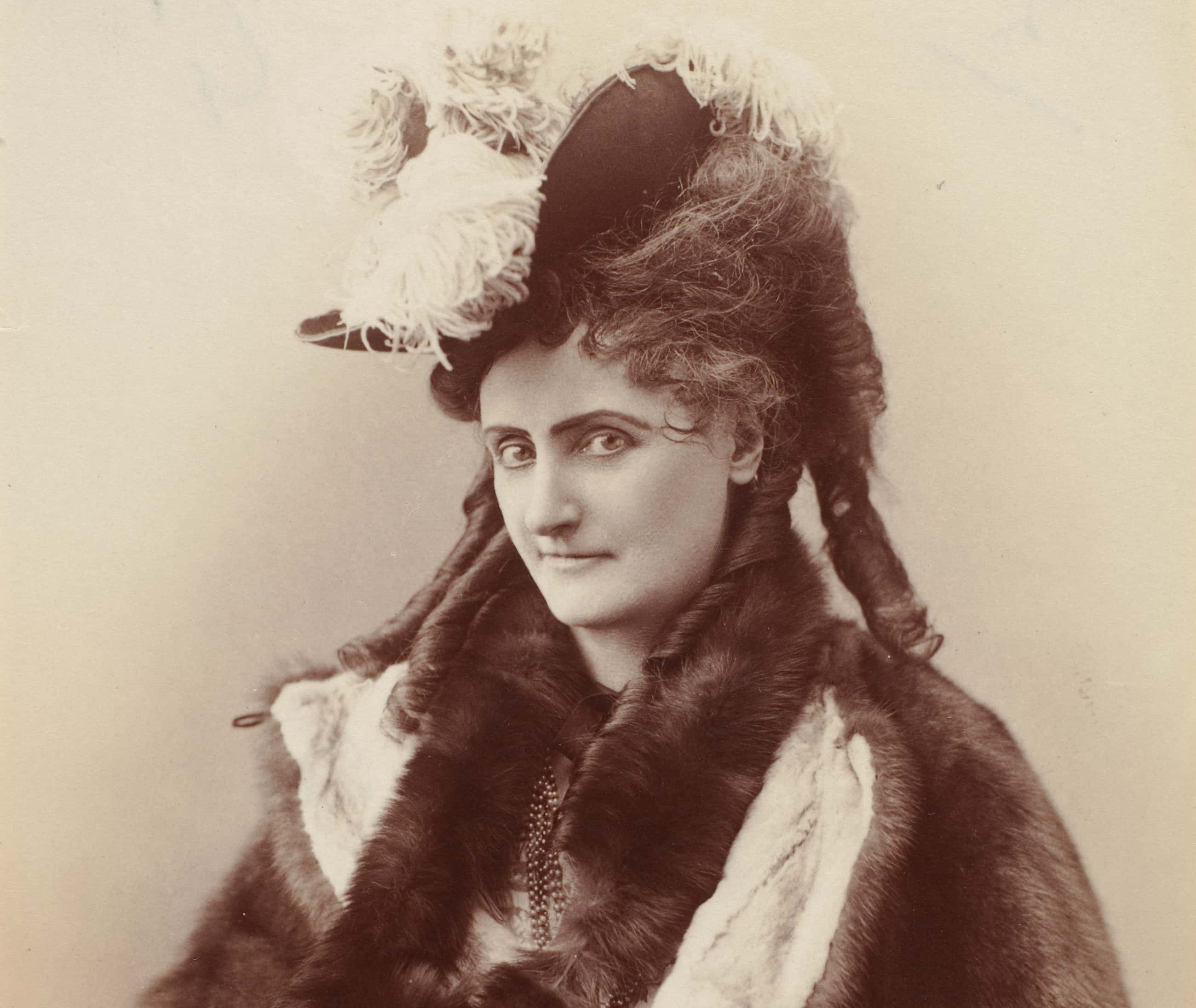They're supposed to be the prim and proper rulers of our world, representing the best that society has to offer, but for some reason, some royals just can't get through the day without causing a royal scandal of some kind, whether they mean to or not. From ancient punishments to illegitimate children to more recent divorces and deaths, each generation of rulers has seen their fair share of royal scandals. Read on for the most outrageous facts about royal scandals out there.
1. Kind of Hard for Queens to Hide Secret Kids Though?
The "Prince Tudor theory" is founded on the belief that Queen Elizabeth I had a secret lovechild who was the secret heir to the throne the whole time. This lost prince was, supposedly, Edward de Vere, 17th Earl of Oxford. According to this school of belief, it’s also why he secretly wrote all of Shakespeare’s plays. If that’s not edgy enough for you, look up the spin-off theory, “Prince Tudor II,” where it's claimed that Elizabeth accidentally sired another lovechild off her own son and that inbred baby is Oxford.
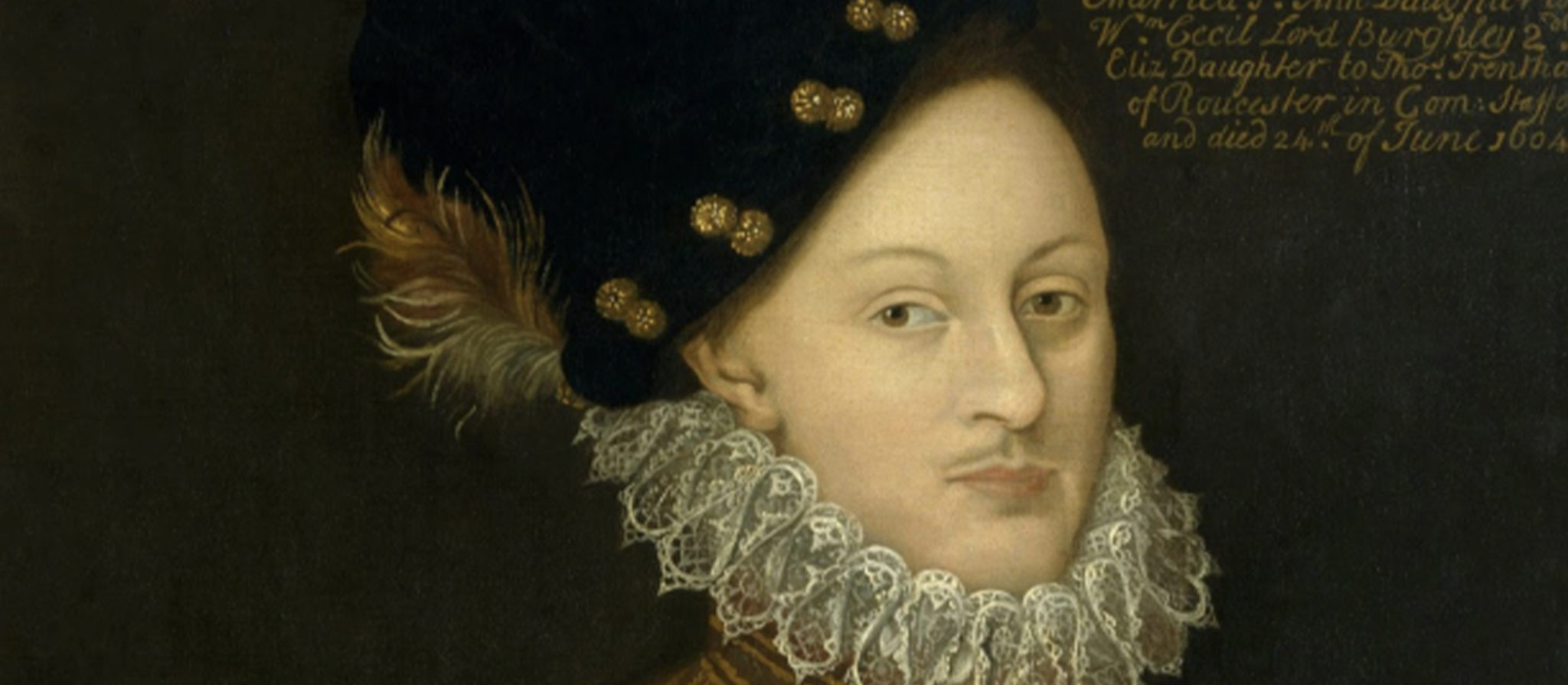
2. Dear Old Dad
In 47 BC, Cleopatra showed up on Julius Caesar’s doorstep with a baby and told Caesar that he was the father. The story seemed believable—the baby was, after all, named “Caesarion”—but that would have caused political difficulties for Caesar, who was married at the time, and who had already adopted another heir, Octavian.
While Caesar allowed Cleopatra and her son to remain in Rome, he continuously denied the child was his and had a friend, Gaius Oppius, distribute a pamphlet “proving” Caesar wasn’t the father.
3. End Of An Empire
Caesarion would go on to rule as the last pharaoh of Egypt. Following Caesar’s passing, Mark Antony had Caesarion formally recognized as Caesar’s son and granted him control of some Roman territories in the east. This infuriated Octavian and instigated the conflict which proved to be Antony—and Caesarion’s—downfall.
4. The Original Burning Man
A 1380 royal ball to celebrate the marriage of a lady in waiting turned into a gruesome scene when King Charles VI of France and four companions caught on fire. To celebrate, Charles and his buddies had dressed up in shaggy, woolly costumes and danced around, pretending to be wild men. Charles’ brother, the Duke of Orleans, drunkenly knocked over a torch, setting all five men alight.
Charles was saved, but the other four noblemen perished while the assembled guests looked on in horror. When the citizens heard the news, they attempted to stage a revolt, more furious about the lavish decadence of the party than the deaths of the four noblemen. Talk about royal scandals!!
5. The More the Merrier (But Not That Much)
Charles II of England is famous for his big hair, big bedroom appetite, and big brood of illegitimate kids. While his marriage to Catherine of Braganza produced no issue, Charles fathered at least 20 illegitimate children with his mistresses. However, he formally acknowledged “just” 14 of them.
6. The Sharpshooter
King William II of England was by no means a very popular king, but he seemed to have no shortage of hunting buddies. It was on one of these hunting trips that King William wound met his end, shot through the heart with an arrow. William’s hunting partner, Walter Tirel, admitted to firing the arrow and claimed it was an accident.
The haste with which Tirel—and the rest of the hunting party—fled the scene, and the fact that they didn’t bring the king’s body with them, led many to suspect William’s passing was the result of a conspiracy. Tirel was, after all, the best archer of the bunch.
7. Vegas, Baby!
What happens in Vegas doesn’t always stay in Vegas. Prince Harry learned that one the hard way, when, after a night of partying, he was caught completely undressed after playing strip billiards in some cell phone photographs taken by another party-goer. Maybe pick another destination for the bachelor party, Harry!
8. No Wonder She Became Bloody Mary
Mary I, commonly known as Bloody Mary, was the eldest child of Henry VIII and his first wife, Catherine of Aragon. She was declared illegitimate when her father divorced her mother and sent her away. Mary and Catherine weren’t allowed to see each other because they refused to acknowledge the new Protestantism or Henry’s new queen, Anne Boleyn. Mary wasn't even allowed to attend her mother's funeral when she passed on. Safe to say she grew up with a few grudges.
9. History is Written by the Victors
Mary I only got her nickname of Bloody Mary because of her persecution of Protestants in England. While more than 200 Protestants were indeed burned at the stake, Mary’s reputation for savagery and tyranny was greatly built up by Protestant writers of the time and in later years. Mary’s efforts to restore Catholicism were completely reversed after her passing due to a lack of heirs, which led to Elizabeth I being crowned Queen and restoring Protestantism to favor.
10. Hate You Less
Louis XIV of France referred his own illegitimate kids as “mules” because they were “unnatural” and weren’t allowed to reproduce. However, Louis also had an “Olympian disdain for public opinion,” which might be why he nonetheless made good marriages for his brood and even legitimized them against the people’s wishes. Spite is a wonderful thing.
11. The Loophole
Following the passing of Henry V in 1422, a law was passed which, in theory, would have prevented his widow, Catherine, from having any further children who might challenge Henry’s own son for the throne. The law required that Catherine get consent from an adult king to remarry. What the law failed to do was make any such marriages invalid.
Catherine did remarry—to a Welsh servant, no less—and their ensuing offspring would go on to form the Tudor dynasty.
 hervedumont.ch
hervedumont.ch
12. Loyal Servant
Catherine’s new husband, Owain ap Maredudd ap Tudur, literally fell right into her lap. He had been carousing and tripped while dancing. Owain continued to serve the Lancaster family long after Catherine passed on: he was executed by Yorkists at age 60 following the Battle of Mortimer’s Cross.
13. Marrying Down
Cecily of York was the sister-in-law of Henry VII. She was also married to Henry’s uncle, Viscount Welles. But when the Viscount passed on, Cecily remarried Thomas Kyme, a humble country squire from Lincolnshire. Henry was furious—an unmarried sister-in-law could have been a good diplomatic bargaining chip—and he seized all Cecily’s property and banished her from his court.
14. Alright, You Can Come In
Not unlike his English counterpart Charles II, Louis XIV of France struggled with fertility within his own marriage, but he had no problem siring children outside of wedlock. He had only one surviving son by his wife, but he and his own son passed. This left only a young great-grandson as his heir. Such scarcity in “true princes” might be why he legitimized two sons by his chief mistress, Madame de Montespan, much to the scandal of everyone.
15. Difficult Divorce
The oft-married Henry VIII was no stranger to controversy. In his obsessive pursuit of a male heir, Henry frequently flung caution and propriety to the wind, but his boldest move was divorcing his first wife, Catherine of Aragon. Henry’s insistence on divorcing Catherine of Aragon and marrying his mistress Anne Boleyn ran afoul of the Roman Catholic church. Henry was excommunicated, which ultimately led to the creation of the Church of England.
 Paranormal Whisperer - WordPress
Paranormal Whisperer - WordPress
16. Equal Opportunity Execution
In the days when Henry VIII was getting ready to burn all the bridges in the world by divorcing his wife to marry Anne Boleyn, one woman turned to prophecy to stop him. In 1532, a Catholic nun (and mystic) named Elizabeth Barton prophesied that if the King married Anne Boleyn, he would die and suffer for an eternity in the afterlife. She was promptly imprisoned by the next year and forced to admit that she’d made it all up (which, let's be fair, she probably did).
Barton was beheaded for her treason and her head was put on a spike on London Bridge. She remains the only woman in history to have her head decorate the bridge.
17. No Love Lost
Anne Boleyn showed no lack of disdain for her predecessor, Catherine of Aragon. She refused to attend Catherine’s funeral, prevented Catherine’s daughter Mary from attending, and spent the day parading around the castle in bright yellow. Rumors spread that Anne had threatened to murder Catherine and Mary, and Catherine’s passing led many to suggest that Anne had finally made good on her threat.
18. Losing Her Head
Anne Boleyn herself proved to be the source of much controversy. She was unpopular with the people for her role in Henry’s divorce and her treatment of Catherine of Aragon after, but when she failed to produce a son for Henry, he made plans to get rid of her. A slew of men—including Anne’s own brother, George—were accused of committing adultery with Anne Boleyn. All denied the charges. Nevertheless, Anne was beheaded for adultery, and treason.
19. That Didn’t Take Long
The day after Anne Boleyn’s beheading, Henry VIII got engaged to Jane Seymour, Anne Boleyn’s lady in waiting. While she was publicly proclaimed queen, her coronation never went ahead due to an outbreak of plague.
 pinterest
pinterest
20. Frenemies
Jane was not only Anne Boleyn’s lady in waiting, she was also Anne’s second cousin. The two women had been close friends at Henry’s court until Anne noticed the necklace Jane wore. The necklace featured a small portrait of Jane’s lover—Henry VIII. Anne angrily snatched the necklace from Jane’s hand, leading to what modern witnesses would probably describe as a “catfight.”
21. The One?
In 1537, to Henry’s great relief, Jane became pregnant with a son. Sadly, Jane Seymour passed due to complications shortly after giving birth to the future Edward VI. She remained the only one of Henry’s wives to be given a royal burial, and Henry was buried beside her upon his passing in 1547. The question now remains: was she the one, or was it the son?
 The Tudors (2007–2010), Showtime Networks
The Tudors (2007–2010), Showtime Networks
22. Which One?
King Henry VIII was a pretty heartless bugger, and as much as people have romanticized his great love for Jane, having a son and heir was always his number one priority. Jane’s labor was difficult, and when asked by a female attendant whether he wanted to save the mother or child if it came down to it, he supposedly replied “If you cannot save both, at least let the child live," followed by the characteristic statement "for other wives are easily found.” Priorities, right?
23. Renaissance Tinder
After Jane Seymour passed from complications after giving birth to Edward VI, Henry VIII began the search for his next wife. In order to choose, Henry was sent paintings of possible partners. He chose Anne of Cleves over her sister Amalia, but was unhappy with his choice when he finally saw her in person. Apparently, she wasn't quite the looker he had hoped for.
He called her a “fat, Flanders mare,” and had the marriage annulled after just six months. At least she kept her head!
24. Off With Her Head!
16 days after annulling his marriage to Anne of Cleves, Henry VIII (now 49) married the 19-year-old Catherine Howard, who had been Anne of Cleves' lady-in-waiting. Less than a year into their marriage, rumors of her infidelity began, and after gathering evidence of her promiscuity, Henry had her executed in 1542.
 Wikipedia
Wikipedia
25. The Bedroom Addict
Ibrahim I of the Ottoman Empire was the last heir of his line. As such, it behooved his supporters to keep Ibrahim’s mind on procreation. Unfortunately, their efforts worked too well, and Ibrahim became a full-on intimacy addict. His orgies and affairs shocked the empire, and rumors spread that “Ibrahim the Mad” even had a harem of 280 women drowned so that he might have the pleasure of picking new women.
26. The Fast and the Furious
The court of Louis XIV was the site of many affairs and debauched events, but nothing scandalized Louis more than a breach of etiquette. Louis had invited his court, including his wife, Marie-Thérèse, to join him in Flanders. His very pregnant mistress, Louise, had been given strict orders, however, to stay behind in Paris.
Nonetheless, eager to prove her love to the king, Louise hired a carriage and set out, at points engaging in all-out drag races with the Queen’s own carriage. Louise arrived first at Louis’ camp, but she was disappointed: Louis remarked only with a shocked “Madame before the Queen?!”
27. 60% of the Time, We’re 100% Sure
The Scots Kings got around. King James IV of Scotland is mostly remembered by the English for his grisly ending and also being a brother-in-law to Henry VIII of England. But he managed to leave his own legacy; James had at least eight known illegitimate children from at least four mistresses. It gets spotty because only five survived infancy. While his favorite mistress was Margaret Drummond, people aren’t 100% sure which ones are hers.
28. Fingers Crossed
King George IV was a famous scoundrel; stories of his indiscreet affairs, blackmail, and untold numbers of illegitimate children could fill this whole list. But it is his relationship to the wealthy widow Maria Fitzherbert that takes the cake. After he wrote her a 42-page letter in which he threatened to kill himself if she didn’t sleep with him, Maria relented on the condition that she and George get married, which they did in a secret ceremony.
Luckily for George, Fitzherbert was a Catholic, thus rendering the marriage invalid, preserving his position as heir to the throne of England, and freeing him up to marry his cousin, Caroline of Brunswick.
29. Paging Nicholas Sparks
From then on, George and Maria had a tumultuous relationship. She would demand money and threaten to go to the press if she didn’t get it, he would deny marrying or even knowing her—it was a real “will they, won’t they” kind of thing. When George passed on, however, he asked to be buried with a small miniature of Maria; it was soon discovered that he had saved every one of her letters.
30. Rough Night
In retrospect, George’s attachment to Maria should have been obvious. Contemporary accounts of his wedding depict him breaking out into fits of tears, and getting so inebriated he had to be held up at the altar.
31. Making That Cheddar
The illegitimate children of Pope Alexander VI—also known as Rodrigo Borgia—have enough scandal to fill their own article. But for now, we’ll just mention his most famous natural daughter Lucrezia Borgia, who allegedly dabbled in poisons. However, Lucrezia was also involved in the less nefarious world of mozzarella cheese production. Hey, not unlike ogres, Borgia's lovechildren have layers.
32. The North Remembers
William the Conqueror spent a good part of his early reign silencing disagreement over a Norman being king of an Anglo-Saxon population. These disagreements came mostly from the north of England, and so William decided to teach the northmen a brutal lesson. He laid waste to the lands north of the Humber, making them uninhabitable for humans. Over 100,000 are said to have met their end from starvation or by William’s forces, and records show a marked drop in the population thanks to William’s efforts.
 Getty Images
Getty Images
33. Awkward Funeral
William the Conqueror's life as certainly more dignified than his ending. First, he likely passed after the pommel of his saddle injured him and ruptured his intestines. Not a great look. Then, during his funeral, a man interrupted the proceedings by complaining that the church they were in was built on his family’s lands without giving any compensation in return.
As if that wasn’t bad enough, William’s body had swollen, and couldn’t fit inside the sarcophagus that had been built for him. Attempts to shove him in caused the body to burst, creating an unbearable odor during the rest of the funeral.
 Getty Images
Getty Images
34. Family Feud
William II of England, son of William the Conqueror, met his end while hunting in the New Forest in 1100. While it appeared to be accidental, it’s been generally accepted that he was taken out so his younger brother, Henry I, could become king. We’d call this a tragic situation if it wasn’t for the fact that around thirty years before, William’s older brother, Richard, had also passed on while hunting in the New Forest under mysterious circumstances.
Not only that, but Richard’s son, Richard Jr., had passed on in nearly the exact same circumstances just the year before William! We’re starting to think William II wasn’t exactly smart.
35. Fashion Frenzy
Before she became the Virgin Queen, Elizabeth lived in penury, after her mother’s execution. Her father, Henry VIII, ignored and neglected her so completely that Elizabeth’s guardians had to beg the king for finances to provide Elizabeth with clothes that fit her. Later, when she became queen, Elizabeth collected more than 2,000 dresses for herself, and even that wasn’t enough.
She allegedly took a dress from one of her maids of honor out of envy when she saw how good it looked.
36. That’s an Odd Pet
When James VI of Scotland became James I of England as well (the first of the Stuart Kings), he presumably wanted to make sure that he left a memorable impact on history—he was, after all, following Elizabeth the Virgin Queen, perhaps the most famous English monarch of all time. Maybe that's what brought him to keep a pet elephant in St. James’s Park. The elephant was reportedly given a gallon of vino to drink every morning during the winters. We can only hope that it also had its driver’s license taken away until spring.

37. Hopefully, it Wasn’t on Backwards
One way that the Stuart dynasty is memorable in the history of England is that it featured the first and only English king to be executed. Charles I was famously deposed, put on trial, and beheaded for treason at the end of the English Civil War. Executing a king was a big deal, and maybe some people were still a little uncomfortable about it afterwards because Charles’ head was then sewn back onto his body for burial.
38. Family Doctor
Christian VII ruled Denmark from 1788 to 1808. At least, that was the official line. For most of his reign, Christian was battling mental illness, incapable of running the nation. When the king was incapacitated, the work of running the country usually fell to his wife, Caroline Matilda, and whoever else happened to be on hand. The king’s physician, Johann Friedrich Struensee, was around a lot. Like a lot.
Struensee was in fact practically running the country himself. And he was actually doing a pretty good job: he helped pass significant reforms like the abolition of physical torment and freedom of the press. That same press would soon point out that Caroline Matilda’s new baby looked kind of familiar—really familiar if you knew what Johann Friedrich Struensee looked like.
39. The Head Surgeon
Struensee and Caroline Matilda secretly ran Denmark for close to a year, but their reforms made them many enemies. Eventually, the affair was brought to the attention of the King, who, despite the new laws on physical torment, had Struensee’s hands cut off. And then his head.
40. A Load Of Horse****
According to one story, Catherine the Great met her end after being crushed by a horse in the middle of an intimate act. While the story gained popularity among Catherine’s detractors, historians confirm it was just a myth meant to discredit the Tsarina. Catherine the Great actually passed from a stroke.
41. Look at My Stripes
Caterina Sforza had two dings against her: she was a woman in 15th century Italy and she was baseborn. Her father, the Duke of Milan, acknowledged her at the age of four and her life would never be boring again. She was arguably the biggest threat to Borgia supremacy, even charging into battles on horseback while seven months pregnant. Sforza’s martial exploits earned her the thoughtful but menacing nickname, “La Tigre.” Not bad for a lovechild.
 Wikipédia
Wikipédia
42. Infelicitous Behavior
After marrying in 1981, Prince Charles and Princess Diana sustained a rather rocky marriage. Both were involved with extramarital affairs before they eventually divorced on August 28, 1996. The marriage troubles and divorce were major tabloid news in Britain throughout the 1990s.
43. Annus Horribilis
The marriages of Queen Elizabeth II’s three divorced children all ended in one tragic year: 1992. Princes Charles and Andrew, and their wives Princess Diana and Sarah, Duchess of York, were dragged through the media by tabloids, which in Britain can be even more sensational than those in the US. The affair between Prince Charles and Camilla Parker-Bowles as well as his wife Princess Diana’s infidelities were much-publicized.
In addition, on November 20, 1992 (the Queen’s wedding anniversary) a fire broke out in Windsor Castle, the Queen’s residence, causing extensive damage. Elizabeth would later refer to 1992 as annus horribilis, Latin for “horrible year”.
44. Top Secret
In 1999, a successful request made under the Freedom of Information Act revealed that the NSA, the major intelligence agency for the United States, had placed Princess Diana under surveillance. Because of national security concerns, the contents of her file cannot be revealed.
45. Who Wants That Attention?
Princes Harry and William were just in the early teens when they woke up to the news their mother, Princess Diana, had passed on in a car crash. Amidst the royal family’s polarizing response to Diana’s passing in 1997, it was their grandfather, Prince Philip, who convinced William and Harry to walk behind her coffin. When the young princes were apprehensive, Philip reportedly told his eldest grandson, “If you don’t walk, I think you’ll regret it later. If I walk, will you walk with me?”
At the funeral, Philip, William, Harry, Charles, and Diana’s brother followed the bier all the way from Westminster Abbey to Buckingham Palace, as millions watched.
46. Not A Touching Story
In 1880, Queen Sunanda Kumariratana was sailing to her summer palace when her boat capsized and she drowned. There were many witnesses, but none dared save her: to touch the queen was a capital offense.
47. The Playful Prince
The Victorian Era: proper, prim, repressed. The Victorian code of morals was not a good suit for Victoria’s eldest son, the future King Edward VII. A notorious womanizer who carried out affairs with the most famous actresses of the day, Edward earned the name “Edward the Caresser.” When Edward got caught sneaking an actress into an army camp, his father, Prince Albert, traveled to Cambridge to lecture Edward on propriety.
48. Turning A Blind Eye
Edward’s lowest moment came when he was made a central figure of the Mordaunt divorce trial. Lady Mordaunt had given birth to a daughter who, by all appearances, was blind. Fearing the child’s blindness was a complication of syphilis, Lady Mordaunt confessed to her husband that she had taken many lovers, including the Prince of Wales. Lord Mordaunt filed for divorce, but the court found Lady Mordaunt not mentally fit for the divorce to be granted, and she was sent to an asylum.
Historians now agree Lady Mordaunt was suffering from post-partum depression. On a happier note, little Victoria Mordaunt would go on to regain her sight.
49. PAV
Prince Albert, Edward’s father, grew weary of his son’s shenanigans, but to discipline him would be the pot calling the kettle black. After all, Albert had been implicated in the Cleveland Street Scandal, in which it was discovered that several British aristocrats—the Duke of Beaumont chief among them—had solicited relations with several young telegraph boys.
Claims of Albert’s involvement were never substantiated, but several letters exist alluding to the participation of “one very distinguished person (PAV)” who had to be protected. PAV may very well be “Prince Albert Victor.”
50. Queen Victoria’s Late Love
Queen Victoria took the passing of her beloved husband, Prince Albert, very hard. She even blamed his end on stress caused by their son Edward’s behavior. “The Widow of Windsor” made few public appearances after Albert passed on, but she did supposedly find love later in life, however, in the form of her servant, John Brown.
Their close relationship was the source of much gossip in royal circles, and the Queen’s chaplain even claimed on his deathbed that he performed a secret ceremony between the two.
51. Break and Enter
John Brown may have paid a visit to Queen Victoria’s bedchamber, but he wasn’t the only one. Edward Jones, the gangly teenaged son of a London tailor, made a hobby of breaking into Queen Victoria’s room at Buckingham Palace. The Queen had caught him several times, and even carried out conversations with “the Boy Jones,” but his visits had to come to a stop when he was caught trying to take the queen’s knickers.
52. The Forgotten Son
Prince George, the Duke of Kent, was dubbed “the forgotten son.” He was certainly someone the British royal family seemed eager to forget. George’s partying ways—including the use of hard substances and very public affairs with both men and women—were a constant source of embarrassment to the rest of his prim and proper royal family.
Their disapproval was so obvious that when George met his end in a plane crash in 1942, many suspected the royal family had planned it.
53. American Woman
Perhaps the biggest royal scandal of the 20th century came when the sitting King of England abdicated his throne. King Edward VIII took the throne in 1936, following the passing of his father. There was just one problem: Edward was in love with Royal Scandals facts, a commoner from Baltimore who was already on her second marriage. This was a major no-no among the British aristocracy.
It also conflicted with Edward’s role as head of the Church of England, which disapproved divorce—sorry, did they forget what they had been created for? Either way, as his entire cabinet said they would resign if he proposed, Edward’s insistence on marrying Wallis—as soon as her divorce finalized, of course—threatened to launch Great Britain into a constitutional crisis.
54. Hands Tied
As a compromise, Edward offered the idea of a morganatic marriage, also known as a left-handed marriage, which would have him remain king without extending any official title to Wallis. The British Parliament refused, leaving Edward with no choice but abdication.
 A&E
A&E
55. Happily Ever After
Edward and Wallis were married in France in 1937. Not one member of the British royal family attended—they’d been forbidden from doing so by Edward’s newly-crowned brother, King George VI—and the Church of England refused to sanction the wedding. Edward and Wallis would remain in France, happily married, until Edward’s passing in 1972.
56. The Hardest Working Man in Royalty
Thought the Edward/Wallis Simpson story seemed more like “great love story” rather than scandal? Well, it wasn’t all making huge sacrifices for love. After the abdication, Edward was given the title of Duke of Windsor and a relatively small allowance. While the French government exempted him from taxes, and the City of Paris provided him with a home which was essentially rent-free, Edward found his allowance too restrictive, and took to writing, affecting political favors, and trading currency illegally to make ends meet.
57. Friends in Low Places
And again, proving that a great love story isn’t everything: while Edward remained despised by the British royal family, at least one European ruler continued to treat him like royalty—Adolf Hitler. Edward was sympathetic to the Nazis during World War II, meeting with The Führer a number of times, and publicly advocating for a peaceful resolution between Great Britain and Germany. Some historians even believe the German leader had plans to reinstall Edward on the throne as a puppet monarch had he won the war.
58. Mother of The Year
Irene of Athens clawed her way to power. An orphan, she was literally picked from a lineup to be the wife of Leo VI, emperor of the Eastern Roman empire. Leo passed on while their son, Constantine VI, was still too young to rule, which left Irene in charge. By the time Constantine came of age, Irene decided she kind of liked the whole “emperor” thing, and when he demanded his rightful throne, she had his eyes gouged out, leaving him to die of his wounds.
59. You Reap What You Sew
Irene got hers in the end: some Byzantine nobles conspired against her and placed her Minister of Finance, Nikephoros, on the throne. Irene was banished to Lesbos, supporting herself by spinning wool.
60. Family Feuds
Henry II of England was not a popular king during his lifetime. In fact, he spent the last years of his life putting down violent rebellions by his own sons against himself or each other. Interestingly, the son who arguably gave him the most grief was Prince Richard (later known as the Lionheart) while his favorite son was Prince John (yes, that Prince John).
John was loyal to his father for a long time until the very end of his life, when he joined Richard in negotiations with the King of France against their father. It’s said that the shock of John’s betrayal was what caused Henry’s final collapse and eventual end.
61. That’s Nuts!
The Borgias weren’t royalty in the strictest sense, but as one of Italy’s elite ruling families during the Renaissance, with very close ties to the Pope, they may as well have been. When the Borgias weren’t using their wealth and power to agitate Italy’s other ruling parties, they were throwing themselves lavish, decadent parties, such as 1492’s Banquet of the Chestnuts.
Featuring 50 unclothed prostitutes—and one pope—the Banquet of the Chestnuts devolved into a full-on swinger's party, with prizes given to the guests who “performed” most frequently.
62. Nice Ink
King George V was a sensitive boy raised to carry the burden of the entire British Empire on his back. But few people know that hidden underneath his proper demeanor and noble regalia was a royal secret: George had a tattoo. Though we might find this shocking today, tattoos were quite popular in England in the 19th century. While he was on a visit to Japan in 1881, George had a local artist give him a blue and red dragon on his arm right before he was scheduled to meet the Emperor. Pretty cool, George.

63. Handsome Remains
Henry VIII’s sister-in-law, Joanna, became the Queen of Castile following her mother’s passing. Joanna’s ascension to the throne meant a significant loss of power for her father, Ferdinand II, who was king of Aragon, but only king-consort to Castile. His power was further threatened when Joanna married Phillip the Handsome, a member of the powerful Hapsburg family.
It didn’t take long for Phillip to turn up lifeless; many suspected Ferdinand had him poisoned.
 Musée de la Chasse et de la Nature
Musée de la Chasse et de la Nature
64. La Loca
Joanna was devastated by Phillip’s passing, and began traveling the country with his coffin in tow, refusing to bathe or sleep without the coffin near her. Throughout Castile, she came to be known as “La Loca.” Her mental state deteriorated progressively for nearly 15 years, during which time Ferdinand II passed on and a power struggle for the kingdoms of Spain arose.
Joanna’s son Charles I seized the throne and had Joanna committed to a monastery, where she spent the rest of her days.
 just history posts - WordPress
just history posts - WordPress
65. The Fairy Tale King
King Ludwig II of Bavaria was known by his people as the Fairy Tale King. It was not a compliment. Rather than attend to the affairs of state, Ludwig spent all his time designing the admittedly magnificent Neuschwanstein Castle, a castle so ornate it was later used as the inspiration for Sleeping Beauty’s castle at Disneyland.
Though he paid for construction with his own money and private loans, Neuschwanstein put Ludwig in debt to the tune of $204 million. Instead of providing him with a requested bailout, the Bavarian government opted to simply remove Ludwig from the throne.
 Byte Sized Biographies
Byte Sized Biographies
66. The Height of Luxury
Built high atop Mount Säuling—at an elevation of nearly 7,000 feet—Neuschwanstein followed the Romantic style, drawing some of its style especially from the Middle Ages, but it was also fitted with modern conveniences like central heat and telephone lines. At the height of construction, the project employed 300 craftsmen.
It was unsuitable for actual governing purposes and intended purely as a residence/playhouse for Ludwig, but in the end, he only lived in the castle for 172 days.
67. No Happy Ending
Removed from his throne, and declared insane by a team of psychiatrists, Ludwig holed up in Neuschwanstein with a small private army. It took two tries to arrest him, but he was finally removed from his beloved castle and put in the custody of psychiatrist Dr. Bernhard von Gudden. The final moments of Ludwig’s life remain shrouded in mystery: the day after his arrest, both he and Dr. Gudden were found in a lake near Munich.
It was ruled that he ended himself by drowning, but an autopsy later revealed that no water was found in his lungs and two bullet holes were found in his jacket.
 Stuff You Missed in History Class
Stuff You Missed in History Class
68. The Acting Head Of State
King Ludwig II’s namesake, Ludwig I, didn’t do anything so outlandish as bankrupt his country building a castle, but he did have troubles of his own. Ludwig I fell deeply in love with a stage actress, Lola Montez, going so far as to make her a countess. Montez would wield her influence in a way some might call “kinda dictator-ish,” silencing dissidents and closing universities. When the people of Bavaria began to revolt, Ludwig I was forced to abdicate the throne, and Countess Lola was forced to flee.
69. Too Much, Too Soon
Lola Montez’s next stop was America, where she resumed her acting career. All things considered, Lola’s time as dictator of Bavaria was just one event in a lifetime of scandals that included two marriages, a murder charge, and affairs with such 19th-century notables as Franz Liszt and Alexandre Dumas. Montez passed at 39 years old, having lived more in those few years than whole cities of people do in their lifetimes.
70. Halfises Don’t Count?
Henry VIII of England’s generosity towards his illegitimate son caused his wife, Catherine of Aragon, a bit of grief, seeing as she “only” had a daughter, Princess Mary. In 1528, a Pope’s legate in England named Cardinal Campeggio reported that Henry’s succession woes might be resolved by wedding Mary…to her own illegitimate half-brother, Henry Fitzroy.
To quote Campeggio’s letter, "They have thought of marrying the Princess, by dispensation from his Holiness, to the King's natural son, if it can be done. At first, I myself had thought of this as a means of establishing the succession, but I do not believe that this design would suffice to satisfy the King's desires." Thankfully, this didn’t come to fruition… but who else feels this Man of God kind of really underreacted to the idea of royal sibling marriage, even if one half of the equation was illegitimate?
71. Signing Her Birth Away
Henry VIII famously illegitimized his eldest daughter, the future Mary I, in the process of annulling his marriage to her mother. In 1536, he ordered her to sign a paper accepting her the invalidity of her parents’ marriage and her own base birth. After much pestering, Mary agreed.
72. Don’t Look to Dad for Validation
Contrary to popular belief, Henry VIII never restored either of his daughters Mary or Elizabeth to “legitimacy.” The Act of Succession 1544 made them heirs to the throne after their brother. However, they remained legally “illegitimate” in the eyes of the law.
73. Who’s Your Daddy?
To this day, people theorize that Mary Boleyn’s two eldest children—Catherine and Henry Carey—were not her husband’s. Instead, it’s speculated that they were products of her affair with Henry VIII. Catherine was even said to resemble Henry as she got older. Nevertheless, neither sibling came forward. Henry married Mary’s sister, Anne Boleyn, and the Carey kids enjoyed being just cousins with their would-be half-sister, Elizabeth I.
74. Your Invitations Were Lost in WWII
Despite the humongous global audience of Princess Elizabeth (now Queen Elizabeth II) and Prince Philip’s wedding, the groom’s surviving three sisters were not in attendance. Why? They were married to German princes, some of whom had Nazi political connections. WWII had just ended. Understandably, such guests would not fly well with the people. In fact, none of Philip’s German relatives were present.
75. Off With Her Heels!
The Queen’s corgis were known to be a bit troublesome. Several times the dogs nipped staff, the family, and even the Queen herself! In 1968, Peter Doig demanded that a “Beware of the Dog” sign be erected out front of Balmoral after one of the corgis went after the postman. But, I mean, it’s the postman, what’s a dog to do?
76. From Lover to Friend
While on the outside, Louis XV and Madame de Pompadour's relationship was happy and healthy, modern historians now know that the couple hid a dark secret behind bedroom doors. From 1750 onwards, Pompadour ceased being a bedroom partner to Louis XV. They no longer actually made love. This was attributed to her very poor health.
Over the years as Louis XV’s mistress, she suffered three miscarriages, and also “suffered the after-effects of whooping cough, recurring colds, and bronchitis, spitting blood, … as well as an unconfirmed case of leucorrhoea.” However, her bond to Louis did not dim, as she served as a “friend of the King,” maintaining her influence at court.
77. Saved by My Sense of Style Again
In January 1757, Louis XV survived an attempt on his life thanks to the thickness of his winter furs. The assailant, Robert-Francois Damiens, made his way through the king’s guard and managed to stab him. While he was injured, the furs had cushioned enough of the blade for him to survive.
 YouTube
YouTube
78. Does a Dagger Need a Motive?
For trying to kill the king, Robert-Francois Damiens was drawn, quartered, and had his remains thrown in a bonfire (allegedly while he was still alive, though how anyone could survive being drawn-and-quartered I have no idea). If that weren’t enough, the house where he was born burned down, his father, wife, and child were exiled from France, and her siblings were forced to change their names.
There seems to have been no clear motive behind all this bloodshed: most agree he was simply suffering from severe mental issues and targeted the king over religious disagreements.
79. Paternal & Papal Invasions of Privacy
On October 2, 1533, Pope Clement VII married Catherine off to the French Dauphin (the son of the King), Henri. The couple was lucky to be the same age—just 14 years old—but old men still wormed their way into the honeymoon. Henri’s father, King Francis I, apparently stayed in the bedroom until the marriage was fully consummated, and the Pope visited the couple in bed the next morning to bless the previous night’s “proceedings.” Yick.
80. My Son, My Son, What Have I Done?
On the 15th of November, 1581, Ivan the Terrible finally lived up to his name in the most gruesome way imaginable. At first, everything seemed like it was going right: his son's wife was pregnant with a soon-to-be grandchild and he was ruler of all Russia. But then Ivan witnessed his pregnant daughter-in-law wearing clothes that he determined to be less-than-appropriate.
He proceeded to physically assault her until his son Ivan Jr. heard her screams and accosted his father. Things had already gone way too far, but then Ivan Sr. struck his son’s temple with his scepter in a fit of rage. The head wound proved fatal, much to Ivan Sr.’s horror. He had offed his son and heir, the man who was to succeed him to the throne.
This, coupled with his daughter-in-law’s miscarriage due to the attack, immortalized Ivan’s image as a mentally unstable tyrant capable of ending his own children and ruining his line.
81. I Quit!
The 1560s brought on a serious change in Ivan’s behavior after all the tragedies he’d endured, coupled with the paranoia he felt against his own aristocracy. In December 1564, he shocked Russia by leaving Moscow and abdicating. This put his people in a terrifying position, since they were afraid of a peasant uprising (no idea why Russian nobles would ever fear such a thing).
They ultimately begged Ivan to come back and be their Tsar. Ivan agreed, on the condition that he become an absolute monarch with the power to basically do whatever he wanted. Things must have been pretty bleak, because his terms were accepted.
82. Rebound Remorse
A year after his first wife passed on, Ivan married Maria Temryukovna, who was only 17 and perceived as illiterate. Ivan, however, was stricken by Maria's great beauty. The marriage was one of his least successful. Not only did their only child die young—continuing a grisly trend when it came to Ivan’s offspring—but Maria was unpopular and unable to adjust to life in Moscow.
Upon her end in 1568, rumors abounded that Ivan had poisoned her, though it’s recorded that he went on a witch hunt to find out the true cause of her end, so the truth will never be known.
83. Classic Overbearing Mother-in-Law
Marfa Sobakina was the "winner" of 12 finalists to become the Tsar’s third wife. However, it was a case of the winner being the biggest loser. Marfa’s mother allegedly gave her a potion to make her more fertile. Unfortunately, the potion ended up being poisonous. She was so ill that she could barely stand on the day of her wedding, but the worst was yet to come.
The poor girl passed on a few days later. In the midst of such a disastrous honeymoon, Ivan became more and more paranoid, even ordering his former brother-in-law to a grisly end by impalement.
84. Painful Fury
Ivan was known for his bad temper. One theory for his uncontrollable mood swings and paranoia was the mercury that he began to take as a painkiller. The side effects of mercury would justify his unpredictable emotions.
85. A Bawdy Collection
Catherine the Great’s public and private images were two very different things. She secretly collected bawdy furniture, and even had a cabinet full of naughty treasures adjacent to her suite of rooms. German forces who raided the palace during WII claimed to have stumbled across the boudoir full of furniture, and photographed it. Most of the photographs were lost in the war, and those that remain are believed to be the only surviving evidence of the furniture.
The furniture wasn't the only thing naughty in the Muscovite palaces: Catherine also employed full-time foot ticklers. A long-standing tradition for Russian royalty, foot ticklers would sing racy ballads while tickling their master's feet to provide relaxation and arousal.
86. Hard Labor
Queen Anne had the hardest of times when it came to motherhood. She was pregnant 17 times over the course of 17 years, and only once did she give birth to a child who made it past the age of two. She miscarried a staggering 12 times, and four of her children passed on while still infants. Some medical historians suggest her terrible luck at parenthood was because she suffered from Hughes syndrome, an autoimmune disease that creates frequent blood clots.
87. Missing You, Dad
Queen Victoria’s father, Prince Edward, sadly passed on when Victoria was less than one year old. Her mother, as well as her mother's rumored lover, Sir John Conroy, would act as her guardians from then on.
 pinterest
pinterest
88. This Needs a Musical
Victoria’s childhood was an isolated one. Her mother (also named Victoria) and Sir John Conroy came up with a parenting system which prevented young Victoria from seeing people that weren’t pre-approved by them first. This system, known as the Kensington System, was done to make Victoria dependent on them, which they hoped would continue into her reign as monarch. No wonder Victoria described her youth as “rather melancholy.”
89. Mommy Dearest
In the spring of 1861, after a lifetime of strained relations with her daughter, Victoria’s mother passed. Victoria was at her mother’s side—by then, they were back on speaking terms—and when she went through her mother’s personal letters, she found out that her mother had “loved her deeply.” This made her blame Sir John Conroy for turning her mother against her during her youth.
90. Rumor Has It…
Queen Victoria’s early reign began well until there was a rumor that one of her mother’s ladies-in-waiting, Lady Flora Hastings, was impregnated by Sir John Conroy. This was supported by a noticeable growth in Hastings’ abdomen. Since Conroy had helped make her childhood a living nightmare, and since Hastings had been one of the women who had helped Conroy out in that endeavor,
Victoria made it clear that she believed the rumors (and thus legitimizing them further). However, after Hastings passed on, it was revealed that she had had a tumor on her liver. Victoria, meanwhile, was publicly shamed for spreading gossip to ruin a sick woman’s reputation.
91. Stay Out of My Life!
In order to keep Sir John Conroy in a close and influential position in Victoria’s life, he and Victoria’s mother tried to persuade her to make him her private secretary. Victoria refused every time, however. In fact, when she became queen, she had Conroy “banned from her presence.” Honestly, kudos to her!
92. Triple Threat
Virginia Oldoini—known better to history as the Countess of Castiglione—was born to a family of minor nobles in Tuscany on 22 March 1837. From these relatively humble beginnings, she would rise to become a legendary model, spy, and mistress to none-other than the Emperor of France, Napoleon III.
93. Lie Back and Think of Italy
In 1855, the Countess of Castiglione was tasked with pushing the cause of Italian unity onto Emperor Napoleon III of France—even if it meant pushing other parts too. Her cousin, the Count di Cavour, reportedly told her, “succeed by any means you wish—but succeed!” If that’s not a state-sanctioned license to commit adultery, I don’t want to know what is.
Indeed, political gears weren’t the only things that got turned, and Castiglione soon became the French ruler’s mistress.
94. Hot Gossip
From 1856 to 1857, Oldoini served as Napoleon III’s mistress. This new gig brought her into close contact with powerful folks like Queen Augusta of Saxe-Weimar and the first German chancellor, Otto Von Bismarck. Between rubbing elbows with elites, she passed intelligence from this powerful court to her allies in Italy.
95. She Wears Her Heart (and Your Hubby) on Her Sleeve
Dressed in her Queen of Hearts gown, Oldoini once scandalously entered a royal ball on the arm of her (married) lover, Emperor Napoleon III, right in front of his wife. At least the empress got one quip in. The spurned wife reportedly gave Oldoini’s racy outfit a once-over and told her, “The heart is a bit low, Madame.”
 The Contessa
The Contessa
96. Broken Heart Queens Club
By 1860, Oldoini’s affair with Napoleon III had soured, and she had completely lost favor at his court. The reasons for her sudden fall from grace remain a private mystery.
97. Putting the “Snap” in Snapchat
When the Countess of Castiglione’s estranged husband started trying to claim custody of her only beloved son Giorgio, the Countess sent him a “present” in the mail. When he opened it, he was horrified. It was a seemingly innocent photograph of the beautiful Countess dressed up in a luxurious gown—but when the Count looked closer, his blood ran cold. She was holding a dagger in her hand, and the photo was titled "La Vengeance."
 Shutterstock
Shutterstock
98. This Was a Test, and You Failed
Anne of Cleves was famously discarded by King Henry VIII, but there may be another side to the story. Anne’s first meeting with Henry was a diplomatic blunder: making their way to London, Anne’s party stopped on New Year’s Day 1540 at Rochester, where she took time to look at bull-baiting from the window. Suddenly, an old burly stranger entered the room.
Depending on the account, either this unkempt figure tried to get her attention and was politely ignored by Anne, or he outright tried to kiss and grope her, which understandably caused the young woman to ring the alarms. Unfortunately, the stranger was really Henry VIII in disguise. He had expected Anne to know her “role”—the maiden who could see through her chivalric suitor’s disguise via the power of “true love”…or something.
Anne was unimpressed, so, in emotional self-defense, Henry may have decided to be unimpressed with her.
99. Biblical Bad Boy
Herod the Great was king of Judea. Modern readers might recognize him as the King who wanted to kill Baby Jesus in the Gospel of Matthew. He was also accused of taking out his brother-in-law, whom he had named a High Priest at the insistence of his wife, Mariamne. Suffice it to say, Herod had a bad reputation.
100. That’s Why He Called Her Honey
When you have a bad reputation—as Herod did—people are likely to say outrageous things about you. Things like, “Herod believed his wife Mariamne had committed adultery so he had her executed. But he still loved her, so he had her body preserved in honey and slept with her for another seven years. Then he married a woman named Mariamne II.”
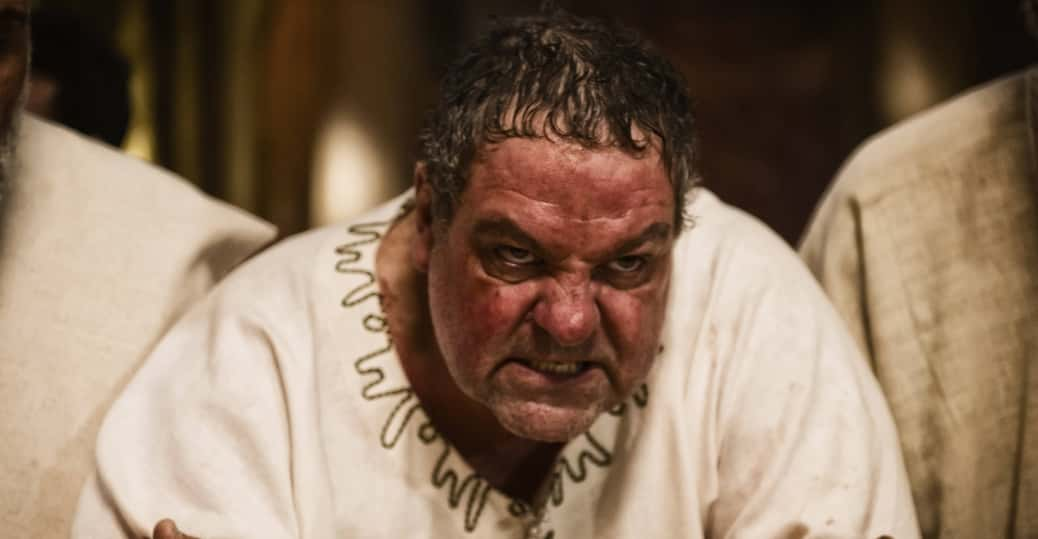 Real Life Villains Wiki - Fandom
Real Life Villains Wiki - Fandom
101. Sick of the King
Herod continued to serve as King, though his Roman emperors often considered removing him from the throne. He remained unloved by his people, who renamed the mysterious illness from which he met his end “Herod’s Evil.”
102. Heart of Darkness
For its time, the cause of Catherine of Aragon’s passing was ambiguous. Her embalmer noticed the body was in perfect health—save for her heart, which had turned black. That led some people to whisper about poison. Today, historians agree generally agree that Catherine succumbed to heart cancer, which—considering the circumstances of her life—appears too poetic to be true.
Sources: 1, 2, 3, 4, 5, 6, 7, 8, 9, 10, 11, 12, 13, 14, 15, 16, 17, 18, 19, 20, 21, 22, 23, 24, 25, 26, 27, 28, 29, 30, 31, 32, 33, 34, 35, 36, 37, 38, 39, 40, 41,









